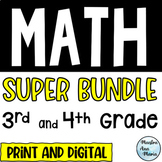Division Word Problems - Division Strategies for Third and Fourth Grade
Bilingual Brain Box
3.9k Followers
Grade Levels
3rd - 4th, Homeschool
Subjects
Resource Type
Standards
CCSS3.OA.A.1
CCSS3.OA.A.2
CCSS3.OA.A.3
Formats Included
- PDF
- Google Apps™
Pages
25 Print & Google Slides
Bilingual Brain Box
3.9k Followers

Includes Google Apps™
The Teacher-Author indicated this resource includes assets from Google Workspace (e.g. docs, slides, etc.).
What educators are saying
Thank you so much for your resource. It worked perfectly for when we worked together. It helped a lot! Thanks so much!
The visuals and multiple representations were perfect practice for my students who struggle to understand these concepts.
Also included in
- Interactive and fun activities to reinforce the following skills:Multiplication with equal groupsMultiplication with array modelsMultiplication word problemsDivision strategies & Division word problemsMulti-step word problemsRounding 2-digit numbers to the nearest tenRounding 3-digit numbers toPrice $48.00Original Price $74.40Save $26.40
Description
This resource is a great way to introduce division. Your students will learn to divide using different strategies such as equal groups, arrays, repeated subtraction and related multiplication. This product includes 50 divisions to practice the different strategies and 10 division problems that will allow your students to visualize division in real contexts. It also includes a poster and 2 vocabulary activities. `
This resource includes the print ✏️ and the digital ⭐ version.
⭐ The preview video shows the digital version!
Check my digital resources:
- Multiplication With Equal Groups and Arrays - Math Riddles - Digital & Print
- Division - Math Riddles - Digital & Print
- Addition - Subtraction - Multiplication - Mystery Pictures - Digital
- Word Problems - Four Operations - Digital and Print
- Word Problems in Spanish - Digital Bundle
- Addition with Base Ten Blocks - Digital Bundle
- Addition in Spanish - Digital Bundle
- Area - Google Form
- Area in Spanish - Google Form
- Rounding - Google Form
- Rounding in Spanish - Google Form
Total Pages
25 Print & Google Slides
Answer Key
Included
Teaching Duration
N/A
Report this resource to TPT
Reported resources will be reviewed by our team. Report this resource to let us know if this resource violates TPT’s content guidelines.
Standards
to see state-specific standards (only available in the US).
CCSS3.OA.A.1
Interpret products of whole numbers, e.g., interpret 5 × 7 as the total number of objects in 5 groups of 7 objects each. For example, describe a context in which a total number of objects can be expressed as 5 × 7.
CCSS3.OA.A.2
Interpret whole-number quotients of whole numbers, e.g., interpret 56 ÷ 8 as the number of objects in each share when 56 objects are partitioned equally into 8 shares, or as a number of shares when 56 objects are partitioned into equal shares of 8 objects each. For example, describe a context in which a number of shares or a number of groups can be expressed as 56 ÷ 8.
CCSS3.OA.A.3
Use multiplication and division within 100 to solve word problems in situations involving equal groups, arrays, and measurement quantities, e.g., by using drawings and equations with a symbol for the unknown number to represent the problem.






